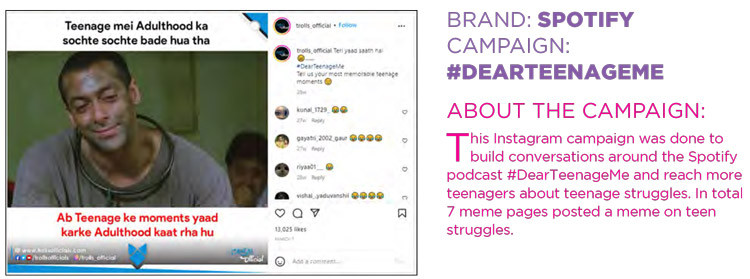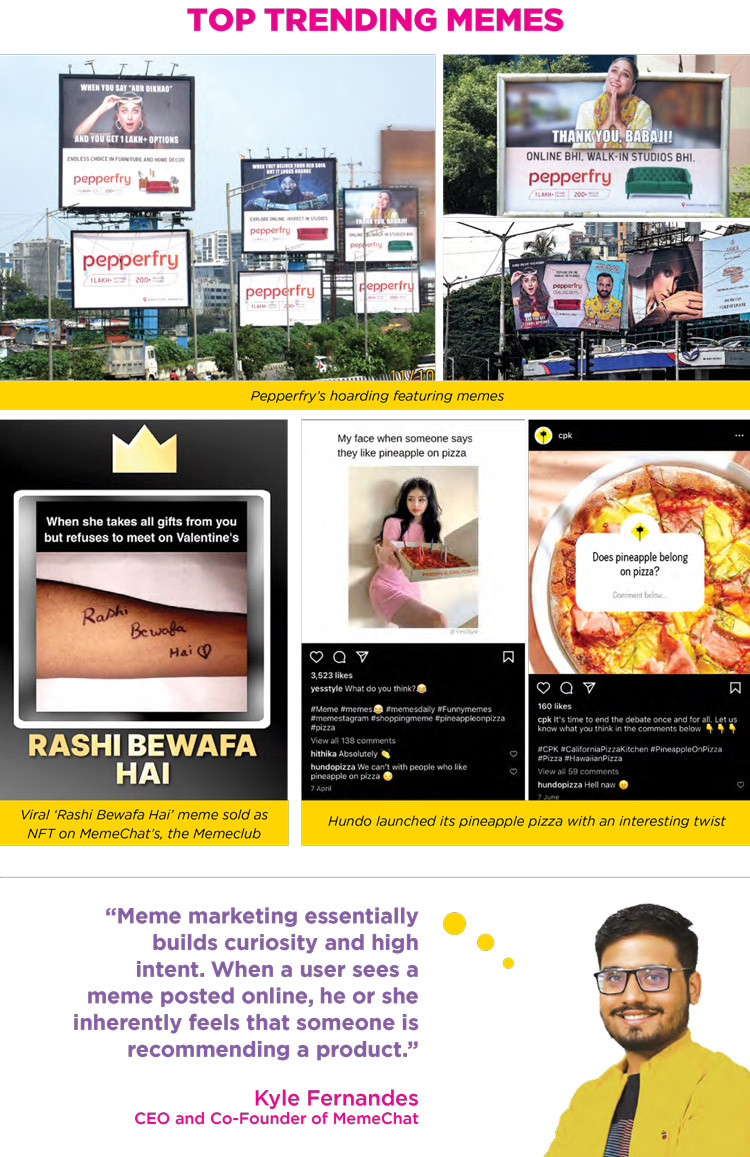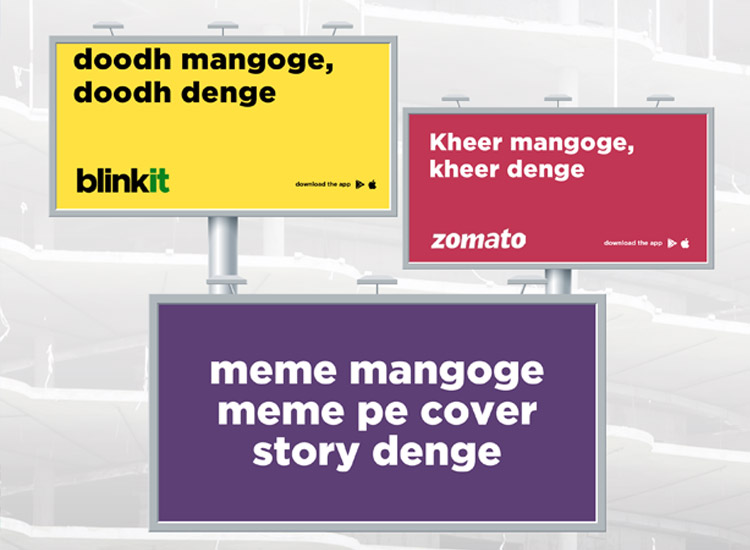Since the past two weeks, a meme has shot to popularity amongst brands and consumers alike, after a prominently placed billboard of Zomato and Blinkit at Golf Course Road, Gurugram, caught social media’s eye. Marketers were quick to line up quirky communications with their own versions of the popular dialogue from the Bollywood film Maa Tujhe Salaam, ‘Doodh Maango, Kheer Denge’. Brands like Adobe, HDFC, Netflix, Housing.com, Mumbai Police, Max Life, JBL, Bingo, Tide, McCain, Prega News, Manforce, Haldirams, etc. had joined the bandwagon in quick succession, much to the consumers’ amusement.
In 1979, Professor Richard Darwin coined the word meme, having reformulated it from the word gene in his book, The Selfish Gene. Little did he know, the internet will take that word and spin it on its head to create a mammoth. Memes may very well bring down governments in today’s time, it has been weaponised to create impact. So, what do we understand by meme marketing? IMPACT digs in deeper to find what makes meme marketing an engaging medium.
As per Kepios analysis, social media users in India increased by 19 million (+4.2 percent) between 2021 and 2022. Looking at the growth of social media users, consumption of meme content grew by 80% in India as per Redseer report 2022.
The growth of meme consumption in India has now led to the growth of brands looking forward to drive their brand messaging organically via meme content on social media platforms. According to experts, brands spend Rs 5 Lakhs and upwards for a single meme marketing campaign. Newer brands now allocate 35-40% of the marketing budget on meme marketing to garner mass awareness in less time. According to WLDD market research, the meme marketing industry in India is currently estimated at around 1000 crores, and is expected to grow to 3000 crores by 2025.
Amit Wadhwa, CEO, Dentsu Creative India, explains how brands today are resonating with meme content, he says, “Pure memes are a fun space. Not every brand is in that space. A lot of our media clients and young start-ups operate there. But I have observed that every brand manages its social media handle with a certain tone of voice, and at any point, there will come a moment that will resonate. Brands can use memes if they are willing to explore, they can follow trends with a slightly more serious version of memes.”
Today, multiple brands in the Digital space, such as, Swiggy, Zomato, Sony LIV, and Netflix post meme content in order to engage with the audience. Two recent examples are - the Subway campaign where a woman asked users to edit out a man photobombing her image, and this resulted in widespread ngagement among social media users; the second example is that of the CRED Bid Blast campaign that took a leaf from classified ads in newspapers, which was seeded online through meme channels. Experts say that brands are leveraging their popularity to connect with the audience. Sony LIV’s Shark Tank season 1 gave Indian internet users multiple memes of Indian businessman and former Co-Founder and Managing Director of the Indian fintech company, BharatPe, Ashneer Grover. All you need to do is remix screen-grabs by adding texts and/or images, to make it funny. This usually resonates deeply with audiences.
Arihant Jain, CEO, Wubba Lubba Dub Dub Pvt. Ltd., a meme and experiential marketing company says, “We use ‘meme culture’ to help brands connect with their audiences more effectively. Brands approach us to develop a meme marketing strategy for their upcoming product, service, TVC, or release, among other things, we also get requests to build core brand recall.”
Jain further says, “We’ve found that the entertainment industry, both films and OTTs, have shown the most interest, followed by consumer tech, e-commerce players, and finance apps. This year has seen a significant increase in the number of FMCG players entering the meme market, which we believe will expand over the next five years to include regional, tier-2, and tier-3 players. In a market like India, the ability to localize the content also plays a crucial role.”
Manish Chopra, Director and Head of Partnerships, Facebook India (Meta) is excited about the meme culture because of its virality factor. He says, “The beauty is that memes just happen. An interesting episode that happened, a slice of life, gets translated into memes. What I am super happy about is that all of this is happening on Meta platforms. That is where it’s spreading, where it’s becoming easy for people to use and see.”
Budgeted Memevertising
Today, meme marketing has become an efficient and cost-effective medium to engage with audiences, especially those between the age group of 18-25. According to experts, meme marketing not only helps audience engagement, but also provides a brand recall.

Spokesperson at Zomato and Blinkit while responding to queries from IMPACT said, “Memes have become a popular way for brands to connect with consumers on social media. They can be an effective way to tap into existing cultural trends and conversations, and can help to create a sense of relatability and shared understanding with audiences. Additionally, memes can be a cost-effective way for brands to produce content.”
MemeChat, an app that enables meme makers to earn money, currently has over 130,000 monthly active users. It currently creates 80,000 - 100,000 memes daily, with around 120k memes being shared. The application has worked with Hotstar, Amazon Prime Video, Moj, Sharechat, EaseMyTrip, McDonalds, India Terrain, Slice, MediBuddy, PVR, NiyoX, MxPlayer, Paytm, Netflix, Zee5, and Codashop to create their user-generated memes.
Kyle Fernandes, CEO and Co-Founder of MemeChat says, “Meme marketing essentially builds curiosity, and high intent. When a user sees a meme posted online, he or she inherently feels that someone is recommending a product, and not directly selling it. But when we as Indians and people in general see an ad, we have less affinity towards it because we don’t want to be sold things and that’s human tendency.”
He further says, “So the intent becomes high enough for a user to check out the product. Second, curiosity increases around the product, and creates power users. The users a brand acquires through meme marketing are highly retainable, as compared to users acquired through inorganic channels.”
Explaining the strategy to make memes viral, Fernandes says, “We have partnered with about 600 meme pages, which have a total following of about 500 million, and all our memes are posted on these channels. So, we are working very heavily on distribution, and we have about 1,50,000 monthly meme creators. We are also trying to expand distribution through APIs, content seeding, and through the MemeChat keyboard that we have.”
He further says, “We pay somewhere Rs 5000-10,000 per branded post. But for organic posts, which are picked from our platforms, we do not pay for them.”
Experts say that brands often prefer Cost Per Thousand Impression module to drive engagement, while many brands often opt for Cost Per Click module. However, Cost Per Acquisition or Cost Per Sale module is not that effective due to the light-hearted content that is often enjoyed for a few seconds on social media platforms.
Jain of WLDD explains how the budget of meme campaigns depends on the deliverables and objectives, “Meme campaigns typically start at around 10 lakh, but can also reach a 10X investment based on the task, brand objectives, and key goals. We’re seeing a trend where brands have fixed monthly meme campaigns for the whole year! This is a huge shift for the meme marketing industry. Being cost efficient, having high visibility, and very high relevance, all packed in one, with the intention of making people smile/laugh, meme marketing is attracting many new-age brands.”
 Memes to drive sales?
Memes to drive sales?
Over time, Memes on the internet have become an engaging crowd puller. Both organic and inorganic meme content have gained a huge traction from netizens.
Jain of WLDD says, “Meme marketing is already driving sales for any product or service that requires demonstration, and the trend has already taken off. Memes will also significantly influence what you watch, consume, and wear in the upcoming years. Given that social media users are expected to reach 448 million by 2023, and the majority of millennials are not interested in the idea of conventional techniques, meme marketing appears to be the go-to strategy here. Memes, in our opinion, will define culture for the rest of the world to follow.”
Ambika Sharma, Founder & MD, Pulp Strategy, explains how a meme content often gets converted into a lead for sales. “Memes are often shared and commented on by users, which can help raise awareness of a brand or product. In addition, memes can also be used to generate leads and sales. For example, if you create a meme that is humorous and relevant to your target audience, it is more likely to be shared, liked, and commented on than a traditional ad or piece of marketing content. This increased engagement can lead to more website traffic, which will ultimately lead to more sales.”
With an interesting take on meme marketing for engagement or sales objective, Sourav Ray, CSO, Cheil India says, “I believe that the key role of meme marketing should be to build audience engagement on social channels. Any impact on sales can be a by-product of the additional affinity that you create. It’s important to understand that audience’s tolerance for brand integration in memes is actually lower than other content formats. Memes are supposed to be organic. It is easy for branded memes to come across as a hard sell, which might actually be counter-productive to sales efforts.”
He concludes, “So, brands should keep audience engagement in focus, and carefully balance the brand message with some genuinely funny content.”
Meme marketing may sometimes come off as a gimmick, especially if they do not resonate with the audience. A meme without an interesting or amusing touch can be problematic. There is nothing worse than an unfunny/witless meme when attempting to do meme marketing.
Echoing on the thoughts of Ray, Avanthika Ravichandran, Group Head, Content and Copy, Admatazz said, “As with any communication that a brand releases, there are a number of factors to be considered before hopping on a trending meme. It is imperative to make sure that the content doesn’t come off looking like it’s a hasty, opportunistic, or distasteful attempt at grabbing attention. Besides, it needs to effortlessly fit into the brand’s ethos and overarching communication tonality, and lean towards community-building rather than sales.”
Vineet Chugh, Head of Marketing at RapiPay says, “Meme Marketing has no direct impact on sales because most times, the content of the meme is not related to your brand or your product. They are mostly topical in nature and are a form of moment marketing. Having said that, a popular Meme, especially if it gets viral, can increase your brand visibility on social media, entice consumers’ interest in your brand, and eventually leads to higher sales. Memes should be created keeping engagement in mind, sales will follow.”
Brand Messaging Done Right
Meme marketing which gets viral organically gives a good brand recall. IMPACT spoke to few experts to understand the strategy of getting the brand message right while creating a meme. It is important for a brand to select the right messaging to avoid social media outrage in today’s hyper vigilant era of netizens.
Explaining about it further, the spokesperson at Zomato and Blinkit said, “It’s important to note that using memes in marketing can also be risky, as their meaning and connotations can be highly dependent on context and cultural understanding. Using a meme in the wrong way or with the wrong audience can result in a failed campaign or even backlash.”
The spokesperson further said, “It is also important for a brand to be authentic in its use of memes and understand the context, audience and subculture of the meme that they want to use. If a brand is able to leverage the cultural moment without exploiting it or being tone-deaf, it can be a powerful way to connect with consumers and generate buzz.”
Explaining how meme marketing can be helpful for brands if the messaging is done right, Divya Batra, Head of Marketing, Haldiram Snacks Pvt. Ltd. said, “It is good for brands who have experienced or used all other social media activities, but it also depends on the brand. Every brand has a different brand essence, and they think differently. But yes, meme marketing does help.”
Aalap Desai, Chief Creative Officer, Isobar India and Taproot Dentsu says, “Meme marketing is a moment which you are trying to use for a brand narrative. The seduction of going overboard is too high. But because we are creating it for a brand, we must be careful of brand guidelines and tonality. To fight the seduction and follow the herd is a constant struggle.”
Talking about the strategies used to engage audience via meme marketing, Yash Kulshresth, Chief Creative Officer, Atom Network says, “We don’t over-intellectualise meme marketing and make it run past heavy strategic filters. If it makes the office laugh, we make it Live. We just make sure that the format is not niche, cuts across regions, and is not stale.”
He further says, “As we start to take meme marketing more seriously, there comes the possibility of them becoming unfunny. It’s not an ad film that needs to tick-mark all the brand filters. It’s a 5-10 second laugh that you want to share with your audience, and if they find it hilarious, they will share it further.”
Explaining how brands can use the right tone of voice to deliver the brand message via memes, Renu Somani, National Creative Director, Thought Blurb Communications says, “All advertising demands critical thinking, and meme marketing is no different. The trick is not to get stuck in a template and keep the creative work fresh, spontaneous, and unexpected. Memes are generally designed for comic effect. And comedy can be ticklish, intelligent, dark, self-deprecatory, dry, and more. Choosing the tone of voice is important. The memes will always be there.”
When asked if brands prefer doing meme marketing on certain occasions or it is a long term retainer agreement with the agencies, Bitesh Singh, Founder and CEO, SocioClout says, “It varies from brand to brand, and also depends on the target audience, if a brand caters to the GenZ category more, they are more likely to spend a good amount on meme marketing throughout the year. Brands with a legacy of many years with a mixed target audience tend to stick to topical happenings, but these are not steadfast rules. More and more brands, irrespective of the years they have been in the industry, are dabbling in meme marketing.”
Memes for brand engagement
ITC Foods joined the latest viral meme banter with Zomato and Blinkit with its “Nachos mangoge, Saath mein dip bhi denge” and “Snacks Mangoge, Madness denge” meme messages. Elaborating on how memes today have become an essential creative to make a connect with consumers, Aishwarya Pratap Singh, Head of Marketing -Snacks, Noodles, Pasta, ITC Foods says, “While brands continue to think of every communication campaign from the prism of “is it digital friendly?” memes offer a perfect way to present a refreshed, yet relevant message to consumers on a frequent basis. Memes are an important tool to stay relevant and show the consumer that you have your finger on the pulse.”
Talking about how Fiama’s ‘Feel Good’ meme campaign generated good response and engagement, Subash Balar - Vice President, Marketing, ITC Personal Care Products Business says, “Meme marketing has sparked social media banter across the younger audience who express larger issues of their life through memes. With this insight, we aimed to reach these Digital savvy audiences, through the existing meme culture and motivate them to have constructive conversations on their state of mental well-being. The brand has attempted to immerse its communication in pop culture through a unique meme video series to help mitigate the stigma of mental health and therapy.”
Saakshi Verma Menon, Marketing Director, Kimberly Clark, believes that meme moment marketing not only brings joy to marketers, but also helps a brand make a connect with the consumers. She says, “For me, meme moment marketing is relevant and will always be so. It only depends on how well you do it, and therefore to me it actually becomes a true test of creativity. Some brands do it really well, and I think it adds a lot to their brand personality and love for consumers.”
Today, meme has become a language in its own right, a fun tool to create a lasting impact. A language of the internet that will only continue to grow as more people partake in the Digital world of things. At such a time, brands will be compelled to make Meme Marketing a part and parcel of their marketing approach.























